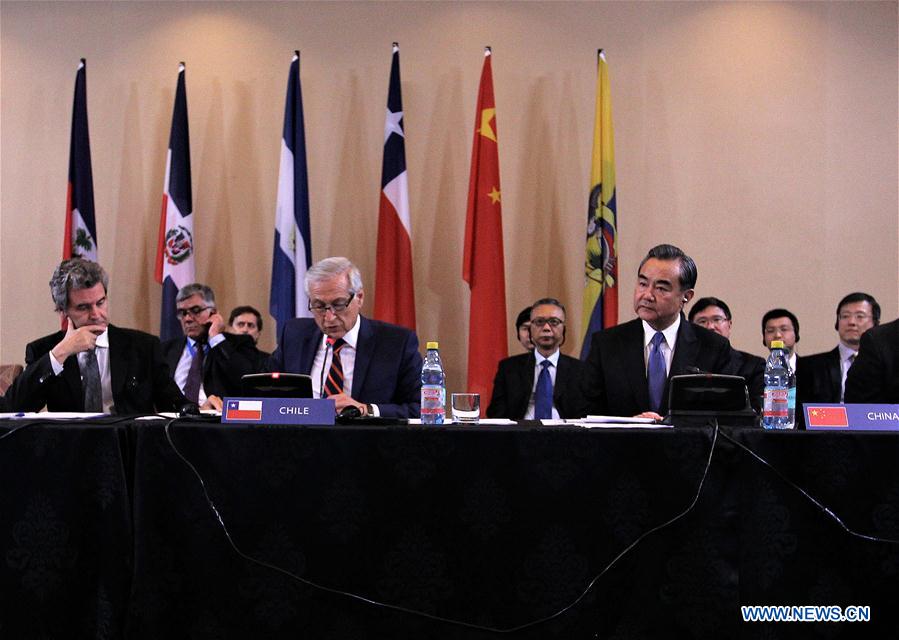CELAC driving for a Silk Road of shared interests
- By Earl Bousquet
 0 Comment(s)
0 Comment(s) Print
Print E-mail China.org.cn, January 30, 2018
E-mail China.org.cn, January 30, 2018

A new Silk Road is under construction, as China and the Community of Latin American and Caribbean States (CELAC) deepen and expand ties, with eyes on shared interests and a common destiny.
Latin American and Caribbean (LAC) expressed quiet interest in China's flagship global project, the Belt and Road Initiative (BRI), at its launch in 2013, and have been reiterated at subsequent meetings in China and the LAC region.
Among the first to show clear interest were Argentina, Bolivia, Brazil, Chile, Ecuador and Venezuela, but at least 21 member-states of CELAC expressed similar interest during the Second Ministerial Meeting of the CELAC-China Forum, held in Santiago, Chile on Jan. 23, 2018.
At a time when multilateralism and global trade are under threat and unity is needed more than ever among countries with shared interests, the Santiago meeting provided an adequate forum for opportunities for cooperation to be explored and agreed upon – and it did achieve significant progress.
The LAC region lost no time in recognizing the mutual benefit of jointly building the BRI across four major frontiers, identifying land, sea, air and digital components for cooperation.
Together, the LAC and China have set their eyes on joint construction of an open world economy that will promote economic globalization and uphold multilateralism in free trade. They aim to ensure collaboration in new areas such as joint battles against drugs, corruption and cybercrime, as well as to further develop ongoing cooperation in traditional areas such as politics and security, financial and trade investment, infrastructure and transportation and people-to-people friendship.
The Santiago meeting saw the firming up of agreements to an earlier-identified three-pronged "1+3+6" agreement, which includes the 2015-2019 Joint China-LAC Countries Cooperation Plan, which had been tabled in 2014 in Brazil. The plan is to be implemented through the three driving forces of trade, investment and finance, utilizing six areas of development: energy & resources, infrastructure, science & technology, agriculture, manufacturing and information technology.
Despite differences in size, resources and realistic inhibitions to greater regional integration, the LAC countries were nevertheless unified in their support for the Belt and Road Initiative. In Chile, the continental states of Bolivia, Chile, Ecuador and El Salvador reiterated their intentions to advance the Silk Road, while the small island states of Barbados, the Dominican Republic, Haiti, Jamaica and Trinidad & Tobago all indicated equal interest in working with China to build a new globalized structure they agree is not only possible, but vitally essential.
The LAC states, big and small, were thinking big in Santiago, wishing to see the Silk Road Economic Belt and the 21st Century Maritime Silk Road enhance trade and infrastructure, as well as network connectivity, by forging a path of cooperation from the Pacific to the Atlantic Ocean and the Caribbean Sea, bringing China and the CELAC states closer together.
The larger LAC countries envision greater connectivity through undersea fiber-optic cables, investment in major infrastructure projects, as well as development of bi-oceanic routes between the Pacific and the Atlantic to reduce travel time to and from China.
For their part, the island-states are interested in greater investments, mutual cooperation, deep sea ports and aerial hubs.
The BRI has attracted LAC interest for the same reasons found in all other continents and regions: mutual and multilateral economic benefit through strategic, peaceful development with trusted allies.
According to official statistics, in the next 15 years China expects to import 24 trillion dollars' worth of goods from across the world and to invest 2 trillion dollars in other countries, including the LAC region.
Bilateral China-LAC trade reached over 166 billion dollars in the first eight months of 2017 – an 18 percent increase over the same period in 2016.
These figures bode well for LAC countries, which are relying on the indications following last year's 19th National Congress of the Communist Party of China (CPC) that innovation will be the principal driving force for China's future development, with application of new technologies in the real economy, such as internet, big data and artificial intelligence.
Equally attractive are indications that China will promote the development of ecological industries to protect the environment, so LAC states are additionally counting on intensifying exchanges in technical research and human resource training, use of renewable energy, environmental management and ecological security.
It is for all these reasons that interested CELAC states, looking at long-term goals, want to deepen strategic cooperation and develop joint agendas for new international relations with China in the years ahead, leading to a global community of common interests and a shared future through the BRI.
Earl Bousquet is a contributor to china.org.cn, editor-at-large of The Diplomatic Courier and author of an online regional newspaper column entitled Chronicles of a Chronic Caribbean Chronicler.
Opinion articles reflect the views of their authors, not necessarily those of China.org.cn.





